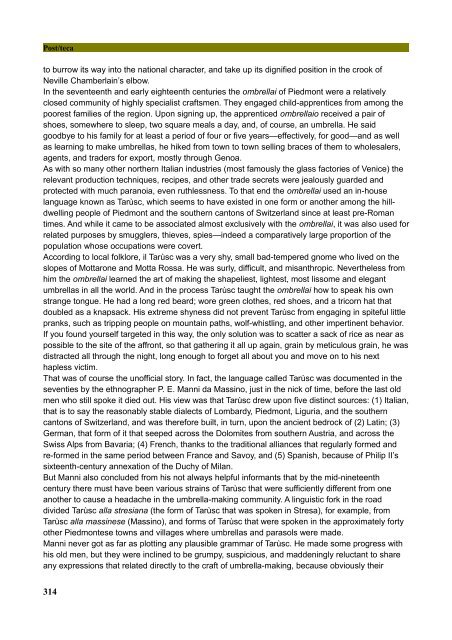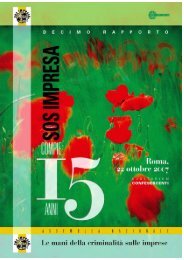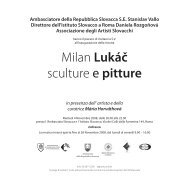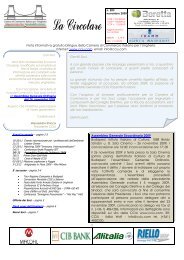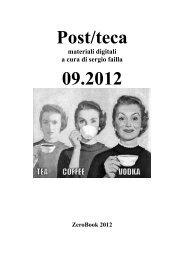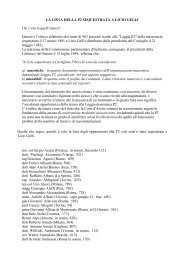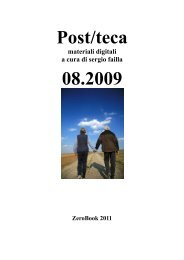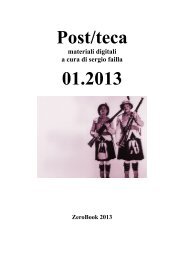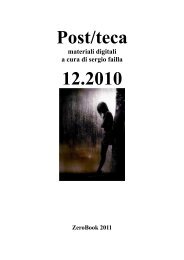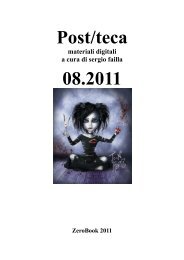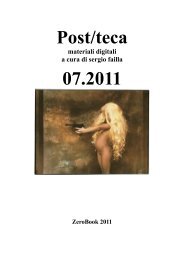postteca201008 (PDF - 3.8 Mb) - Girodivite
postteca201008 (PDF - 3.8 Mb) - Girodivite
postteca201008 (PDF - 3.8 Mb) - Girodivite
You also want an ePaper? Increase the reach of your titles
YUMPU automatically turns print PDFs into web optimized ePapers that Google loves.
Post/teca<br />
to burrow its way into the national character, and take up its dignified position in the crook of<br />
Neville Chamberlain’s elbow.<br />
In the seventeenth and early eighteenth centuries the ombrellai of Piedmont were a relatively<br />
closed community of highly specialist craftsmen. They engaged child-apprentices from among the<br />
poorest families of the region. Upon signing up, the apprenticed ombrellaio received a pair of<br />
shoes, somewhere to sleep, two square meals a day, and, of course, an umbrella. He said<br />
goodbye to his family for at least a period of four or five years—effectively, for good—and as well<br />
as learning to make umbrellas, he hiked from town to town selling braces of them to wholesalers,<br />
agents, and traders for export, mostly through Genoa.<br />
As with so many other northern Italian industries (most famously the glass factories of Venice) the<br />
relevant production techniques, recipes, and other trade secrets were jealously guarded and<br />
protected with much paranoia, even ruthlessness. To that end the ombrellai used an in-house<br />
language known as Tarùsc, which seems to have existed in one form or another among the hilldwelling<br />
people of Piedmont and the southern cantons of Switzerland since at least pre-Roman<br />
times. And while it came to be associated almost exclusively with the ombrellai, it was also used for<br />
related purposes by smugglers, thieves, spies—indeed a comparatively large proportion of the<br />
population whose occupations were covert.<br />
According to local folklore, il Tarùsc was a very shy, small bad-tempered gnome who lived on the<br />
slopes of Mottarone and Motta Rossa. He was surly, difficult, and misanthropic. Nevertheless from<br />
him the ombrellai learned the art of making the shapeliest, lightest, most lissome and elegant<br />
umbrellas in all the world. And in the process Tarùsc taught the ombrellai how to speak his own<br />
strange tongue. He had a long red beard; wore green clothes, red shoes, and a tricorn hat that<br />
doubled as a knapsack. His extreme shyness did not prevent Tarùsc from engaging in spiteful little<br />
pranks, such as tripping people on mountain paths, wolf-whistling, and other impertinent behavior.<br />
If you found yourself targeted in this way, the only solution was to scatter a sack of rice as near as<br />
possible to the site of the affront, so that gathering it all up again, grain by meticulous grain, he was<br />
distracted all through the night, long enough to forget all about you and move on to his next<br />
hapless victim.<br />
That was of course the unofficial story. In fact, the language called Tarùsc was documented in the<br />
seventies by the ethnographer P. E. Manni da Massino, just in the nick of time, before the last old<br />
men who still spoke it died out. His view was that Tarùsc drew upon five distinct sources: (1) Italian,<br />
that is to say the reasonably stable dialects of Lombardy, Piedmont, Liguria, and the southern<br />
cantons of Switzerland, and was therefore built, in turn, upon the ancient bedrock of (2) Latin; (3)<br />
German, that form of it that seeped across the Dolomites from southern Austria, and across the<br />
Swiss Alps from Bavaria; (4) French, thanks to the traditional alliances that regularly formed and<br />
re-formed in the same period between France and Savoy, and (5) Spanish, because of Philip II’s<br />
sixteenth-century annexation of the Duchy of Milan.<br />
But Manni also concluded from his not always helpful informants that by the mid-nineteenth<br />
century there must have been various strains of Tarùsc that were sufficiently different from one<br />
another to cause a headache in the umbrella-making community. A linguistic fork in the road<br />
divided Tarùsc alla stresiana (the form of Tarùsc that was spoken in Stresa), for example, from<br />
Tarùsc alla massinese (Massino), and forms of Tarùsc that were spoken in the approximately forty<br />
other Piedmontese towns and villages where umbrellas and parasols were made.<br />
Manni never got as far as plotting any plausible grammar of Tarùsc. He made some progress with<br />
his old men, but they were inclined to be grumpy, suspicious, and maddeningly reluctant to share<br />
any expressions that related directly to the craft of umbrella-making, because obviously their<br />
314


